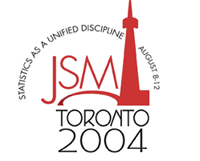|
Activity Number:
|
12
|
|
Type:
|
Topic Contributed
|
|
Date/Time:
|
Sunday, August 8, 2004 : 2:00 PM to 3:50 PM
|
|
Sponsor:
|
Biopharmaceutical Section
|
| Abstract - #301131 |
|
Title:
|
Issues with Phase II/III Combination Designs
|
|
Author(s):
|
H.M. James Hung*+
|
|
Companies:
|
U.S. Food and Drug Administration
|
|
Address:
|
DB1, CDER, Rockville, MD, 20852,
|
|
Keywords:
|
efficiency ; missing data
|
|
Abstract:
|
Combining phase II and phase III may improve efficiency for drug development. The extent of the improvement, however, requires extensive evaluation subjecting to many practical constraints. The typical phase II designs that traditionally are relatively small and study narrow patient populations offer information that is often limited in assisting the planning of phase III trials. Combining phase III designs with such phase II designs may not offer much improvement in efficiency. An informative phase II design needs to allow full exploration of the dose range for efficacy and safety of the study drug. It also needs to facilitate exploration of the nature of dropouts or missing data so that the dropouts or missing data may be minimized and a sensible strategy of sensitivity analysis may be planned to handle missing data. Any useful statistical methods, frequentist or Bayesian, should be used to explore the phase II data. Some parts of such informative phase II data may be combined with phase III data. Issues with such combination include those of what Type I (or false positive) error needs to be of concern, how to combine, and more.
|
- The address information is for the authors that have a + after their name.
- Authors who are presenting talks have a * after their name.
Back to the full JSM 2004 program |
